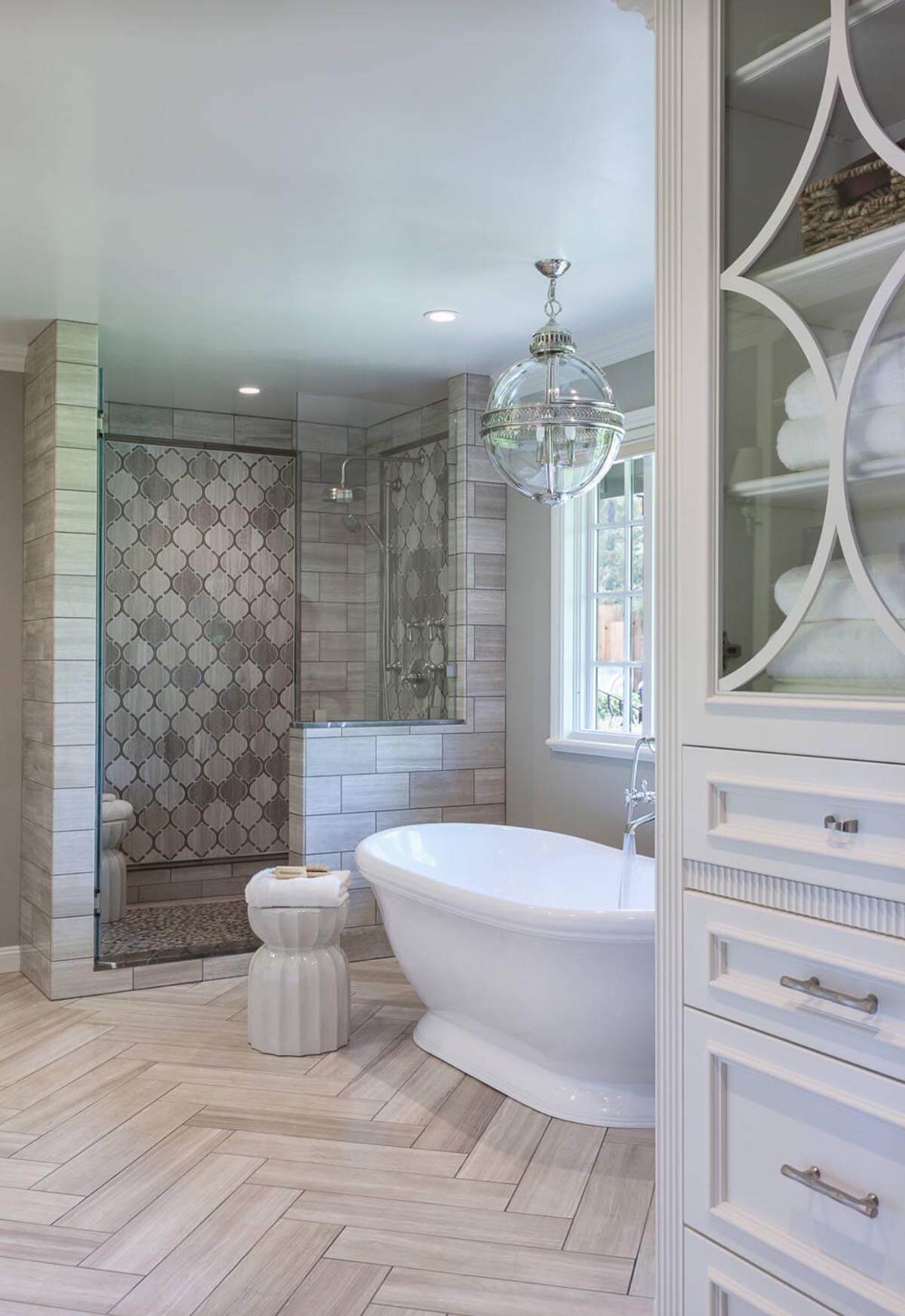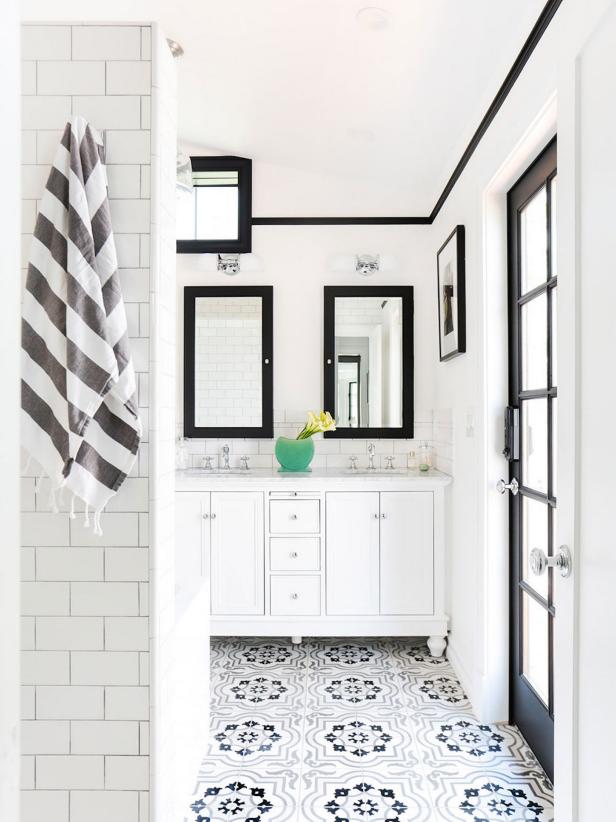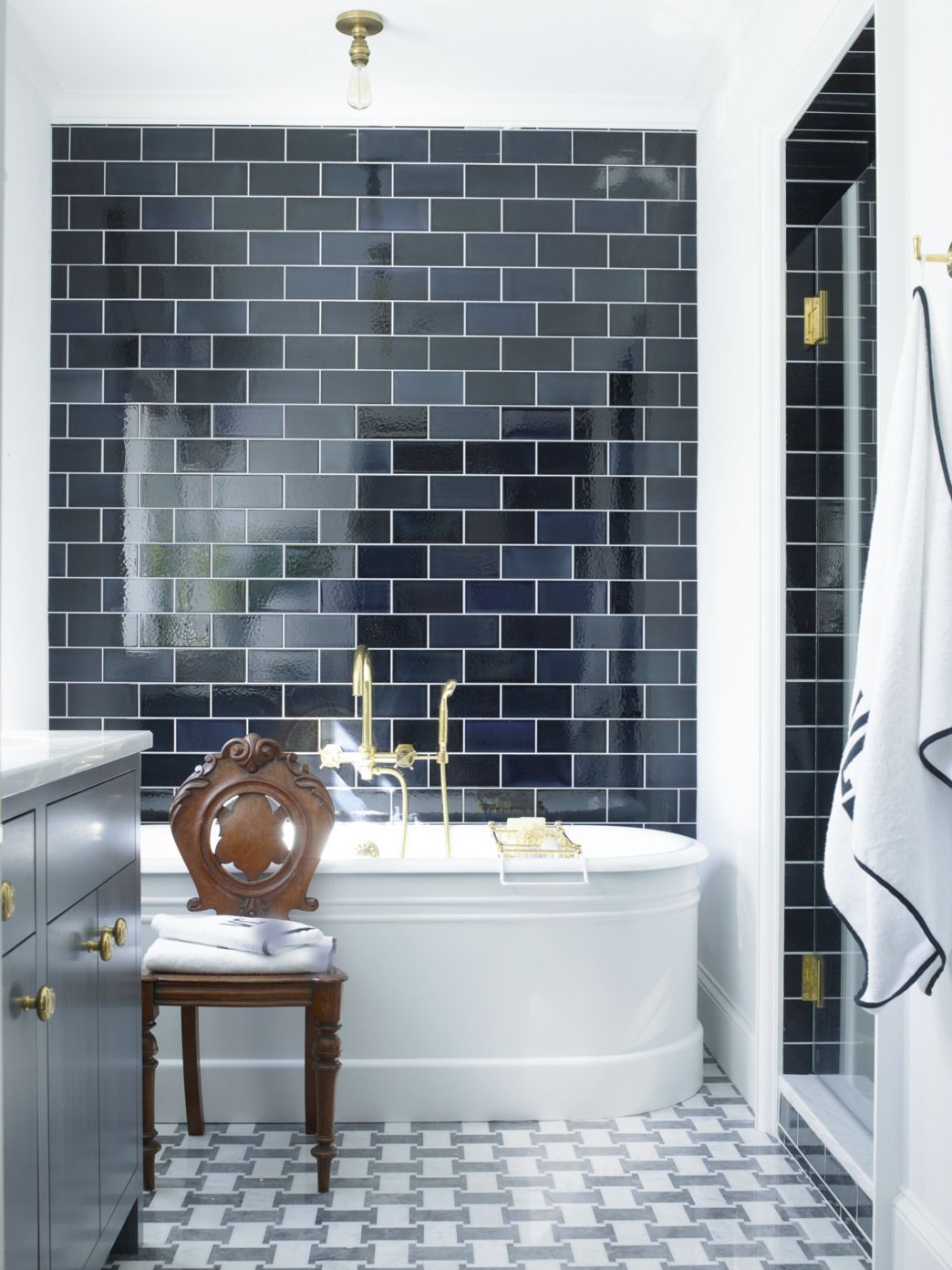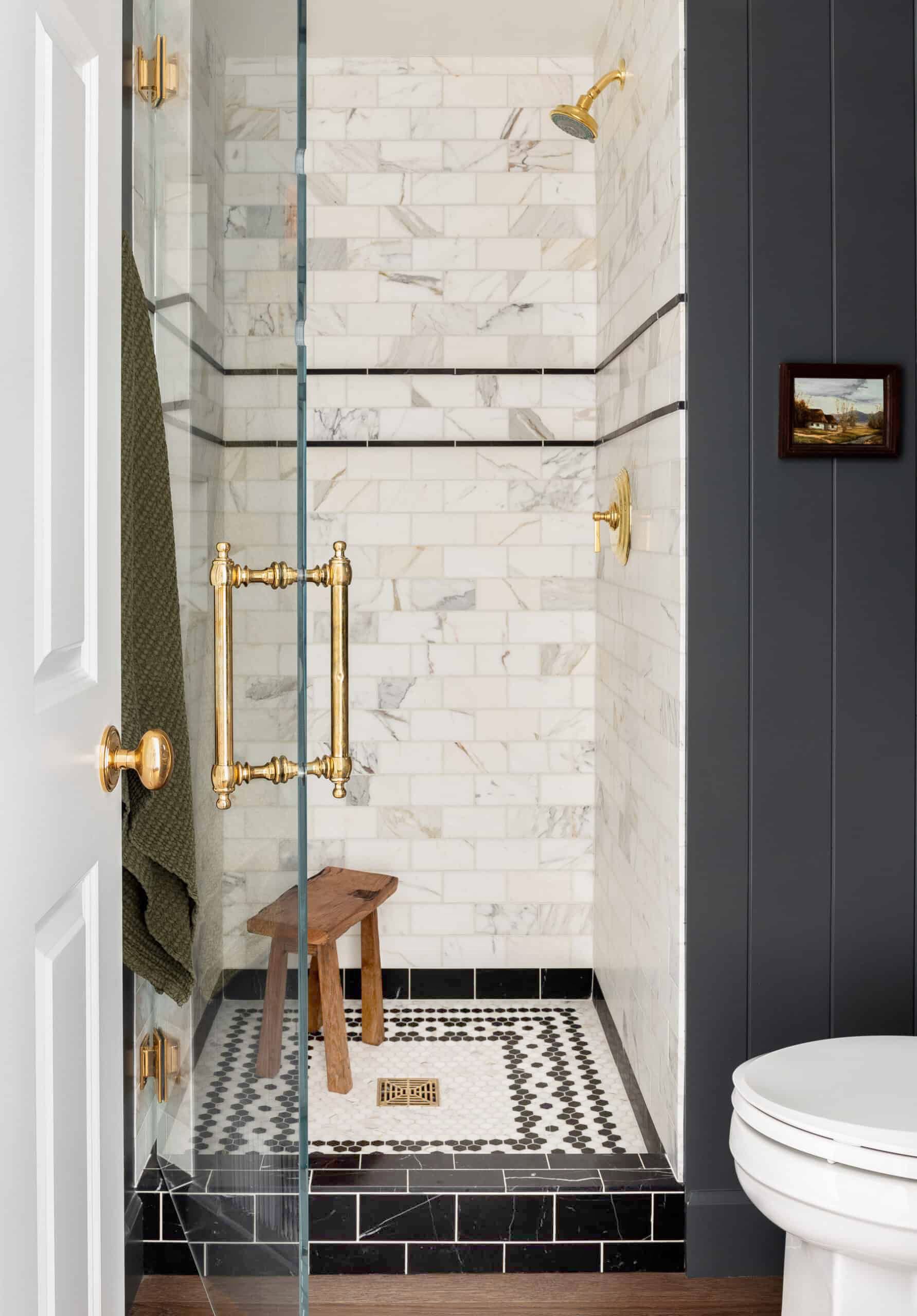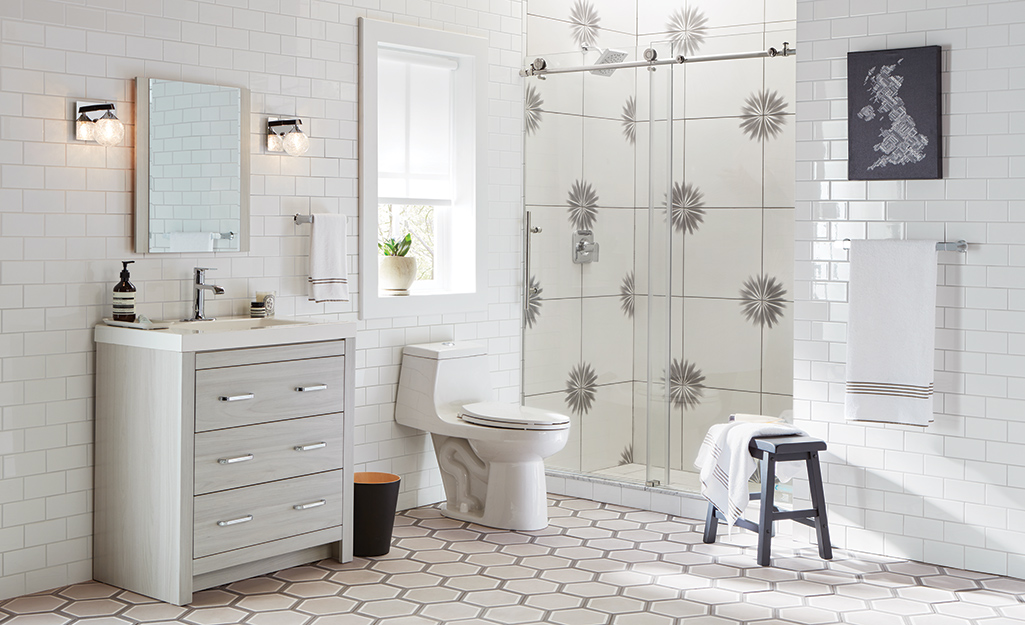Bathrooms are not just functional spaces; they are personal sanctuaries where design plays a crucial role in creating a calming and aesthetically pleasing environment. One of the most impactful design elements in a bathroom is the choice of tile combinations. With countless options available, choosing the best tile combinations can be overwhelming. Let’s discuss some of the most effective bathroom tile combinations, providing inspiration and guidance for creating a beautiful and cohesive bathroom design.
Classic Black and White
- Timeless Appeal: The classic combination of black and white tiles remains a favorite in bathroom design due to its timeless appeal. This pairing offers a sophisticated and clean look that suits various styles, from modern to vintage. Black and white tiles can be used in numerous patterns, such as checkerboard, herringbone, or stripes, allowing for creative expression.
- Versatility: Black and white tiles are incredibly versatile, complementing a range of fixtures and accessories. For instance, you can pair them with chrome fixtures for a sleek, modern look or with brass fixtures for a touch of vintage charm. The neutral palette also allows for easy updates to the bathroom decor over time, as you can change accessories and accents without worrying about clashing colors.
- Enhancing Space: This tile combination can make small bathrooms appear larger. White tiles reflect light, creating a sense of space, while black tiles add depth and contrast. The strategic placement of these tiles can enhance the room’s dimensions. For example, using white tiles on the walls and black tiles on the floor can draw the eye upwards, making the ceiling appear higher.
- Accent Features: Incorporating black and white tiles with accent features can add personality to the bathroom. Consider using a black and white patterned tile as an accent wall behind the vanity or inside the shower. This approach can create a focal point and add visual interest without overwhelming the space.
- Maintenance and Durability: Black and white tiles are generally easy to maintain. Dirt and grime are less noticeable on these colors compared to lighter shades, and both black and white tiles can be cleaned with standard bathroom cleaners. Additionally, ceramic and porcelain tiles in these colors are durable and resistant to water damage, making them ideal for bathroom use.
- Cost-Effective: Opting for black and white tiles can also be cost-effective. Many manufacturers offer a wide range of black and white tiles at various price points, making it easier to find options that fit within your budget. Additionally, the longevity and timeless nature of this color scheme mean you are less likely to feel the need for frequent updates, saving money in the long run.

Bold Patterns and Colors
Making a Statement
For those looking to make a bold statement, combining patterned and colorful tiles can transform a bathroom into a vibrant and dynamic space. Patterns such as Moroccan, geometric, or floral designs can add a unique character to the room. These tiles can be used on floors, walls, or as accents to create a striking visual impact.
Focal Points
Using bold patterns and colors strategically can create focal points in the bathroom. For example, a brightly colored tile backsplash behind the sink or a patterned tile accent wall in the shower can draw attention and become a standout feature. This approach can add depth and personality to the design without overwhelming the entire space.
Balancing Act
When using bold patterns and colors, it’s essential to balance them with neutral elements to avoid a cluttered or chaotic look. Pairing vibrant tiles with white or light-colored walls, fixtures, and accessories can help maintain a harmonious and balanced design. This balance ensures that the bold elements enhance rather than dominate the space.
Mixing and Matching
Experimenting with different patterns and colors can create a unique and personalized bathroom design. Mixing and matching tiles of varying sizes, shapes, and colors can result in a playful and eclectic look. For example, combining small mosaic tiles with larger patterned tiles can add texture and interest to the room.
Durability and Maintenance
Bold and colorful tiles, particularly those made from ceramic or porcelain, are not only visually appealing but also durable and easy to maintain. These tiles are resistant to water and stains, making them suitable for bathroom use. Regular cleaning with mild soap and water is usually sufficient to keep them looking vibrant.
Expressing Personality
Bold patterns and colors offer an opportunity to express personal style and creativity. Whether you prefer a bohemian, contemporary, or retro look, there are endless options to reflect your taste. Incorporating elements such as colorful grout or decorative borders can further enhance the design and make the bathroom uniquely yours.
Neutral Tones with Textured Tiles
Calming Ambiance
Neutral tones, such as beige, gray, and taupe, are perfect for creating a calming and serene bathroom environment. When combined with textured tiles, these colors can add depth and interest without overwhelming the space. Textured tiles come in various finishes, such as matte, glossy, or stone-like surfaces, each contributing to a tranquil ambiance.
Versatile Design
Neutral-toned tiles are highly versatile and can complement various design styles, from minimalist to rustic. Textured tiles can mimic natural materials like wood or stone, providing the aesthetic appeal of these materials without the maintenance challenges. This versatility makes neutral tones with textured tiles a popular choice for bathroom renovations.
Enhancing Light
Textured tiles in neutral tones can enhance the light in a bathroom, making it feel more open and airy. The texture can reflect and diffuse light, adding a soft glow to the room. Using lighter shades on the walls and slightly darker tones on the floor can create a cohesive and inviting space.
Creating Interest
While neutral colors are understated, adding texture ensures the design remains interesting and engaging. For example, using a textured tile on one wall or as a backsplash can create a focal point that adds character to the bathroom. Mixing different textures, such as combining smooth and rough surfaces, can further enhance the design.
Durability
Textured tiles, especially those made from ceramic or porcelain, are durable and slip-resistant, making them ideal for bathroom use. They can withstand moisture and high traffic, ensuring longevity. Their texture can also provide additional grip, reducing the risk of slips and falls, which is particularly beneficial in wet areas like showers.
Easy Maintenance
Maintaining neutral-toned, textured tiles is relatively easy. Regular cleaning with mild soap and water will keep them looking fresh. Textured surfaces can hide minor imperfections and dirt better than smooth tiles, reducing the need for frequent deep cleaning. This practicality makes them an excellent choice for busy households.
Mosaic Tiles for Intricate Designs
Versatile Applications
Mosaic tiles offer incredible versatility, allowing for intricate and detailed designs in various areas of the bathroom. They can be used on floors, walls, backsplashes, and even ceilings. Mosaic tiles come in various materials, including glass, ceramic, and stone, each providing a distinct look and feel.
Creating Patterns
Mosaic tiles are ideal for creating patterns and artistic designs. They can be arranged in various shapes, such as geometric patterns, floral designs, or abstract art. This capability allows homeowners to personalize their bathroom design and create a space that reflects their style and creativity.
Accent Features
Using mosaic tiles as accent features can add a touch of luxury and sophistication to the bathroom. For instance, a mosaic tile border around the mirror or a decorative strip in the shower can elevate the overall design. These accents can break up large areas of plain tiles and add visual interest.
Reflective Qualities
Glass mosaic tiles, in particular, have reflective qualities that can enhance the brightness and openness of the bathroom. These tiles catch and reflect light, creating a shimmering effect that adds elegance and sophistication. This feature is especially beneficial in smaller bathrooms, as it can make the space feel larger.
Color and Texture Variations
Mosaic tiles are available in a wide range of colors and textures, allowing for endless design possibilities. Combining different colors and textures can create a dynamic and visually appealing bathroom. For example, mixing matte and glossy tiles or combining glass with natural stone can add depth and dimension.
Easy Installation
Mosaic tiles are often sold in sheets, making installation easier and more efficient. These sheets can be cut to fit various spaces, ensuring a precise and seamless application. While professional installation is recommended for intricate designs, many homeowners find it manageable to install mosaic tiles themselves for simpler projects.
Natural Stone Elegance
Luxurious Aesthetic
Natural stone tiles, such as marble, granite, and travertine, bring a touch of luxury and elegance to any bathroom. Each stone tile is unique, with its distinct veining and color variations, adding a bespoke element to the design. The natural beauty of stone creates a sophisticated and timeless look that enhances any bathroom.
Durability
Natural stone tiles are incredibly durable and can withstand high traffic and moisture, making them ideal for bathrooms. While they require more maintenance than ceramic or porcelain tiles, their longevity and resilience make them a worthwhile investment. Proper sealing can enhance their durability and protect against stains and water damage.
Versatile Design Options
Natural stone tiles offer versatile design options, from polished marble for a sleek, modern look to honed travertine for a rustic, earthy feel. They can be used on floors, walls, and even as countertops. Combining different types of stone can create a harmonious and layered design that adds depth to the bathroom.
Eco-Friendly Choice
Using natural stone tiles is an eco-friendly choice, as they are a sustainable and biodegradable material. Opting for locally sourced stone can further reduce the environmental impact of transportation. Additionally, natural stone’s durability means it won’t need to be replaced frequently, reducing waste over time.
Enhancing Home Value
Installing natural stone tiles can enhance the value of your home. Potential buyers often perceive natural stone as a high-end feature, making it an attractive selling point. The timeless appeal and durability of natural stone mean that it will continue to add value and beauty to your home for years to come.
Customization
Natural stone tiles can be customized to fit various design needs. They can be cut into different shapes and sizes, allowing for unique patterns and layouts. For example, using large stone slabs can create a seamless look, while smaller tiles can be arranged in intricate patterns for added detail.
Mixed Materials for Eclectic Style
Combining Textures
Mixing materials such as ceramic, glass, metal, and natural stone can create an eclectic and personalized bathroom design. This approach allows for the combination of different textures and finishes, resulting in a unique and visually engaging space. For instance, pairing smooth glass tiles with rough stone can add contrast and interest.
Color Harmony
When mixing materials, it’s important to achieve color harmony to ensure a cohesive look. Choosing a unifying color palette can help blend different materials seamlessly. For example, combining white ceramic tiles with blue glass accents and silver metallic elements can create a harmonious and stylish design.
Highlighting Features
Using mixed materials can highlight specific features in the bathroom. For example, a glass tile backsplash behind the sink, paired with a stone tile floor, can draw attention to the vanity area. This method can emphasize architectural details and create focal points that enhance the overall design.
Adding Personality
Mixed material designs allow for the expression of personal style and creativity. Homeowners can experiment with different combinations to reflect their unique tastes. Whether aiming for a modern, industrial look or a cozy, rustic feel, the possibilities are endless when combining various materials.
Practical Benefits
Each material offers distinct practical benefits. For instance, ceramic tiles are durable and easy to clean, while glass tiles are resistant to stains and water. By combining materials, you can take advantage of these benefits to create a functional and beautiful bathroom. For example, using ceramic tiles on the floor for durability and glass tiles on the walls for easy maintenance.
Dynamic Design
Mixed material designs can create a dynamic and layered look that adds depth and dimension to the bathroom. Combining different tile sizes, shapes, and finishes can result in a multi-faceted design that evolves with changing trends. This adaptability ensures that the bathroom remains stylish and functional over time.
Common Mistakes to Avoid
Ignoring Scale and Proportion
One common mistake in bathroom tile design is ignoring the scale and proportion of the tiles. Large tiles in a small bathroom can make the space feel cramped, while small tiles in a large bathroom can look busy and cluttered. Choosing the right tile size for the space is crucial to achieving a balanced and harmonious design.
Overcomplicating Patterns
While intricate patterns can be visually appealing, overcomplicating the design can lead to a chaotic look. It’s important to strike a balance between complexity and simplicity. Using bold patterns sparingly as accents rather than covering entire walls or floors can prevent the design from becoming overwhelming.
Skipping Proper Preparation
Proper surface preparation is essential for a successful tile installation. Skipping steps such as cleaning and leveling the surface can lead to uneven tiles and poor adhesion. Taking the time to prepare the surface ensures a smooth and durable finish that will last for years.
Neglecting Grout Color
Grout color can significantly impact the overall look of the tile design. Neglecting to choose an appropriate grout color can result in an unpolished appearance. Selecting a grout color that complements the tiles can enhance the design and create a cohesive look. For example, using a contrasting grout color can highlight the tile pattern, while a matching grout color can create a seamless look.
Overlooking Maintenance
Different tiles have varying maintenance requirements. Overlooking these needs can lead to premature wear and damage. It’s important to choose tiles that fit your lifestyle and maintenance preferences. For example, natural stone tiles require regular sealing, while ceramic and porcelain tiles are generally low maintenance.
Not Planning Layout
Failing to plan the tile layout can result in an unprofessional look. Taking the time to map out the tile placement and consider factors such as focal points and symmetry can make a significant difference. Planning ensures that cuts and transitions are minimized and that the final result is aesthetically pleasing.
What are the best tile combinations for a small bathroom?
For a small bathroom, light-colored tiles can create a sense of space and openness. Combining white or light gray tiles with glass or mirrored tiles can enhance light reflection and make the room appear larger. Using large-format tiles can also minimize grout lines, creating a more seamless and spacious look.
How can I make my bathroom look more luxurious with tile combinations?
To achieve a luxurious look, consider using natural stone tiles such as marble or granite. These materials exude elegance and sophistication. Combining them with metallic accents, such as gold or brass fixtures, can add a touch of opulence. Additionally, using mosaic tiles for accents and creating focal points can enhance the overall luxurious feel.
What tile combinations work well for a modern bathroom design?
For a modern bathroom design, combining sleek, minimalist tiles such as large-format porcelain or concrete-look tiles with bold accents like geometric patterns or metallic tiles can create a contemporary look. Using a monochromatic color scheme with varying textures can also add depth and interest to the design.
How do I choose the right grout color for my tile combinations?
Choosing the right grout color depends on the desired effect. For a seamless look, match the grout color to the tile color. For a more defined look, use a contrasting grout color to highlight the tile pattern. Consider the maintenance aspect as well; lighter grout colors may require more frequent cleaning, while darker grout colors can hide stains better.
Can I mix different tile materials in one bathroom?
Yes, mixing different tile materials can create a dynamic and personalized bathroom design. Combining materials such as ceramic, glass, metal, and natural stone can add texture and interest. It’s important to achieve color harmony and balance the different materials to ensure a cohesive look. Using one material as the primary focus and the others as accents can help maintain balance.
Bathroom Tile Ideas: Tips for Choosing Tile Combinations
Bathroom Tile Ideas
Related Posts:
- How To Paint Bathroom Tile Before And After
- Anti Skid Bathroom Tiles Price
- Reglazing Bathroom Tiles Cost
- How To Install Bathroom Tile Backsplash
- Bathroom Tile Before And After
- Bathroom Tile Paint White
- Silver Grey Bathroom Tiles
- Bathroom Tiles York
- Small Modern Bathroom Tile Ideas
- Classic Bathroom Tile Designs
